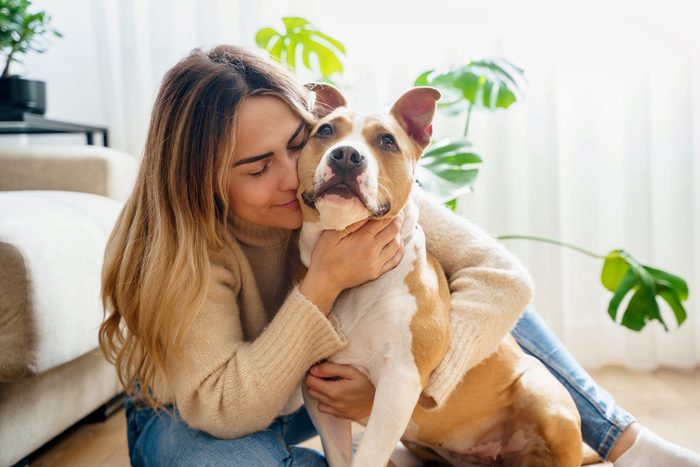
Telltale signs your dog loves you
We love our dogs so much—and we certainly hope they love us too! But how can we be certain? Sure, no one seems more excited to see you than a happy dog wagging its tail when you come home. And love is the reason why your dog follows you everywhere, right? Or is it just because you’re the one who doles out the treats? Well, that’s partly it, we’re not gonna lie, but yes, that shadowing behavior is also one of the signs your dog loves you.
According to experts, the key to decoding canine love signals boils down to paying attention to a dog’s body language. It may look a little (or a lot) different than how humans show love, so we asked vets and animal behaviorists to help us identify and understand a few very specific dog behaviors. Read on to find out how your fur baby really feels about you.
Get Reader’s Digest’s Read Up newsletter for more pet insights, humor, cleaning, travel, tech and fun facts all week long.
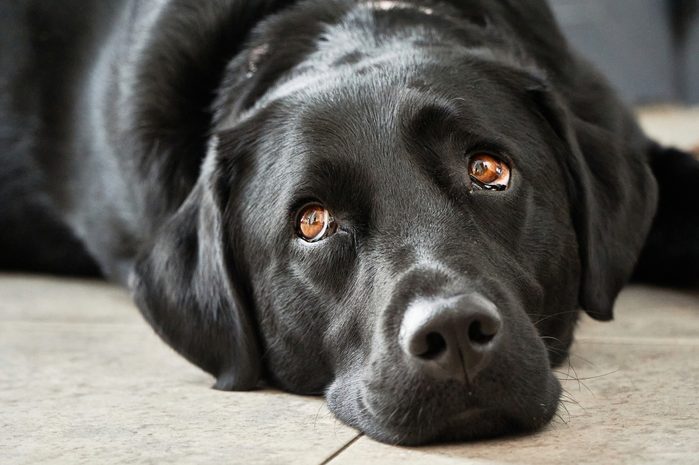
Your dog looks at you with puppy-dog eyes
You know how when you’re just chilling on the couch, watching Netflix, and your dog rests his head on your lap and gazes deeply into your eyes? That’s pup-speak for “I love you, human!”
“Just like humans, dogs use face and body language to communicate,” says Whitney Miller, DVM, director of veterinary medicine for Petco. “Long, intense eye contact from your dog is their way of showing they trust you and show affection toward you.”
And there’s a scientific reason those puppy-dog eyes are so irresistible. According to a study by U.K. researchers published in Proceedings of the National Academy of Sciences in 2018, after dogs were domesticated from wolves, they developed a muscle that raises the inner eyebrow, creating more prominent and expressive eyes to better communicate with us. Interestingly, the Siberian husky is the only dog breed that didn’t develop the muscle, but that’s OK because they have those gorgeous, hypnotizing eyes going for them.
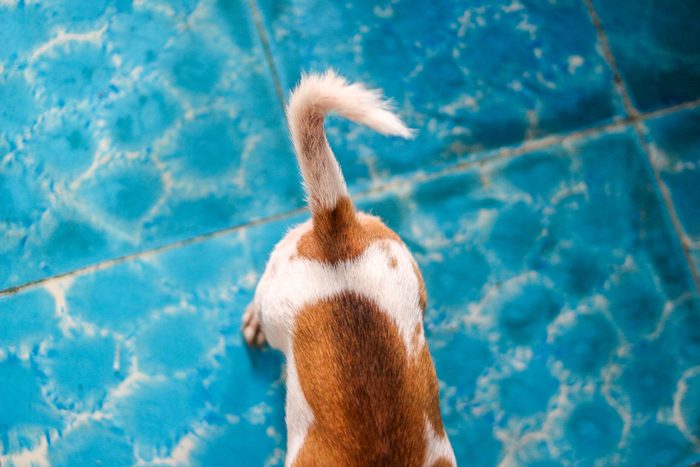
Your dog wags his tail so hard, he goes in circles
Sometimes the simplest signs of love are the truest. Take this sort of extreme tail wagging, for instance. “If your dog’s body language is all loose and wiggly and wagging in a circular motion, this is a sign he’s happy to see you and hang out with you,” says Susan Nilson, an accredited dog training and behavior specialist at The Cat and Dog House, a website that helps pet parents understand their dogs and cats better. And believe it or not, the direction of the tail wag reveals many secrets. For example, when dogs are happy and confident, they tend to wag their tail more toward the right side, Nilson says.
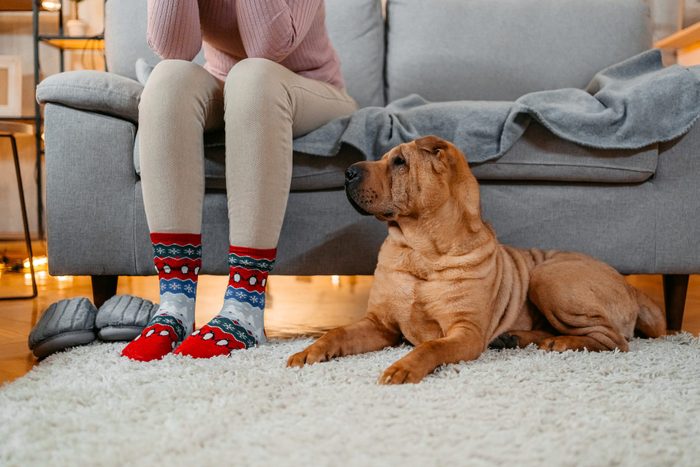
Your dog sticks close to you
It can be annoying to have your doggo always under your feet and following you around, but when you think of it as an endearing sign that your dog loves you, it’s kind of cute. Some dogs don’t play favorites and want to be near all family members, so they may position themselves in a spot in the home where they can keep tabs on everyone and know when they get up. Sally Grottini, a professional dog trainer and behaviorist at JustAnswer Pets, works in the living room, while her husband has an office in the basement. “My dog will position himself in the kitchen so he can take notice if either of us change rooms,” she says. “Once we come together in one room, he will position himself in that room.”
That said, dogs that are also clingy and panic whenever they’re left alone may be following you because they have separation anxiety, Nilson adds. Seek the help of a canine behaviorist to help anxious pups feel more comfortable and to figure out just how long you can leave them home alone.
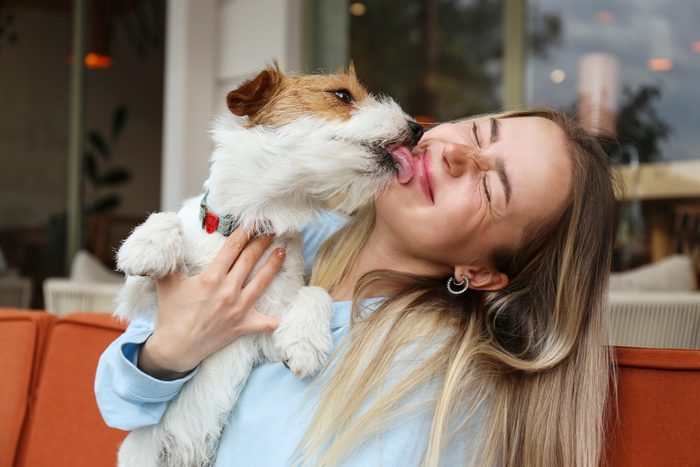
Your dog licks your face
One of the clear signs your dog loves you is when they lick your face—either that, or you have a tasty morsel on your chin! If it’s not food, then you know it’s love. When a puppy licks its mom’s and siblings’ faces, it prompts the release of the feel-good “love” hormone oxytocin in both the licker and lickee. “The behavior is important for creating strong bonds among puppies, and one that some dogs carry into adulthood and transfer to their human family members,” says Nilson. Several studies show that oxytocin levels in dogs increase when they are with us and drop when they’re separated from us. We love those slobbery kisses, but just be aware that your dog might not want a hug or kiss in return and may instead prefer a belly rub or treat.
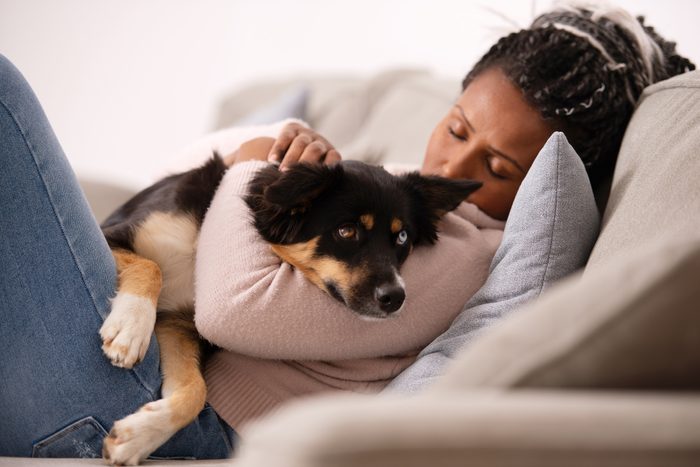
Your dog comforts you when you’re sad
It doesn’t get more heartwarming than those moments when your dog snuggles up close to you when you’re sad or even licks away your tears. But how do they know you’re down in the dumps? Because they are masters at reading human emotions via body language. They have learned that we tend to be less animated and take up less space when we’re sad and subdued, while we tend to be more animated and out there when we’re happy.
“When your dog sees you crying or upset, he may come over to comfort you through physical touch or even licking your tears because he can sense that something is not quite normal,” says Nilson. “However, it’s also possible that he is drawn to the salty taste of your tears!”
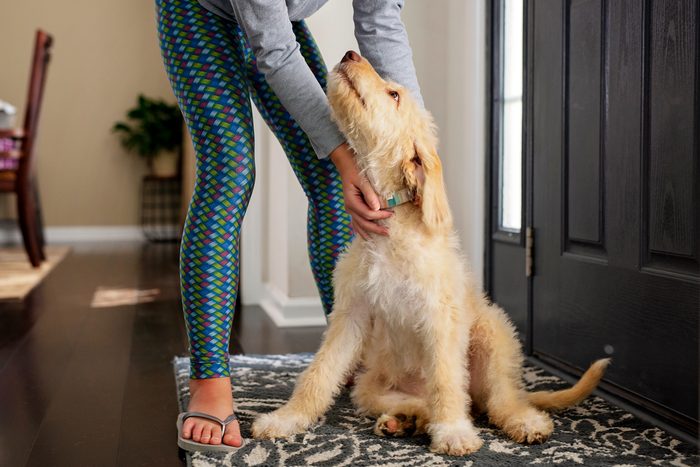
Your dog leans on you
When your dog leans on you with all their body weight, it may not seem like one of the outward signs your dog loves you—especially if you own a giant dog breed and they almost knock you over!—but it is. It’s their way of saying they love and trust us, and it also makes them feel safe. “It’s a way of retaining physical contact, especially when they need reassurance,” says Nilson. Studies show that dogs often use their owners as a “secure base” when they are exploring their environments, just like children do with parental figures.
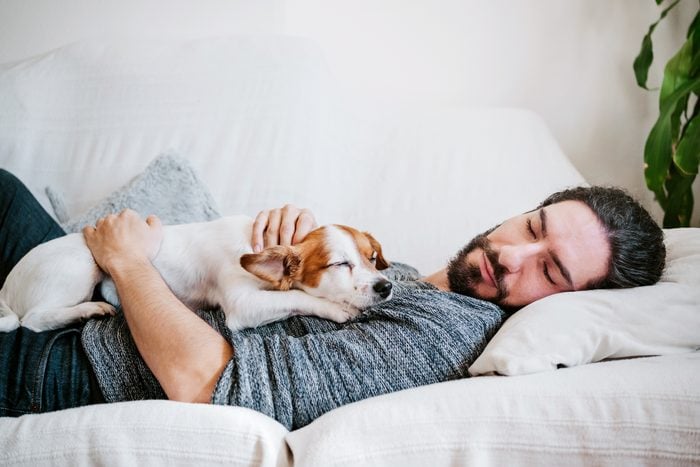
Your dog sprawls out on your body
It doesn’t matter if you have a tiny dog or a huge guard dog that thinks he’s a lap dog when “off duty”—if your dog loves you, he might lay across your feet, legs or whole body. Traditional thinking held that this behavior was an act of dominance, but animal experts now know that getting close and cozy means your dog loves you. “It shows that they trust you and want to be near you, and that your presence is comforting,” says Nilson. “Plus, if you get up and move away, your dog will be the first to know about it, so he can relax in the knowledge that he’s not going to be left alone without realizing it.”
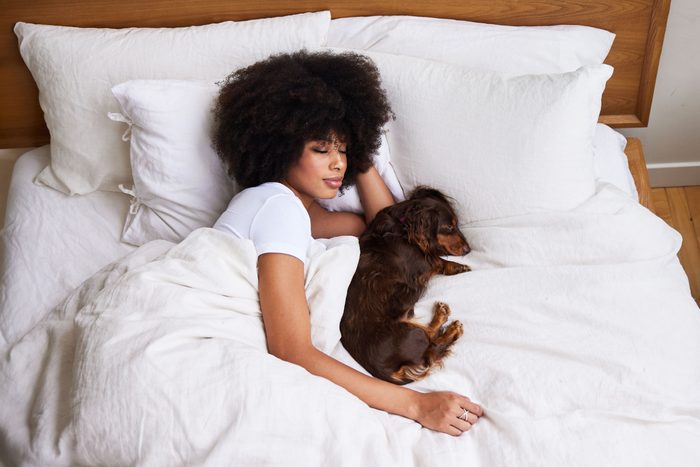
Your dog sleeps near you
Should you let your dog sleep in your bed? While this topic is much-debated among pet parents, your dog has a solid reason for wanting to catch some shut-eye near you—or on you. “Dogs are highly social creatures that form close bonds with their family members, both canine and human,” says Nilson. “As puppies, they snuggle up with their mom and littermates, which helps them forge bonds and equips them with important social skills.” So, lovey-dovey vibes aside, social sleeping (with dogs or humans) is completely normal and means you’re someone they love and trust. “On top of that, co-sleeping provides warmth, comfort and a sense of security, allowing dogs to fully relax and drift off into a deep sleep.”
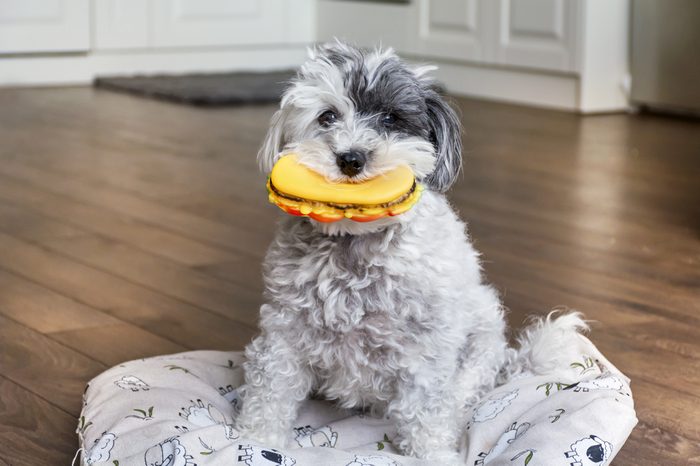
Your dog brings you a favorite toy
Humans like to share their favorite things with those they love, and dogs are no different. Some dogs go cuckoo over a soft squeaky toy, while others prefer to sink their teeth into a tough chew toy. Either way, their favorite toy probably has more meaning than you think. “If your dog brings you one of their favorite toys and drops it at your feet, it’s likely they are giving it to you as a gift,” Dr. Miller says. Doggos look forward to the quality time you spend together, and when their favorite toy is involved, it’s easy to see why they associate the toy with you. “Sharing their favorite things is one way they demonstrate love,” explains Dr. Miller. So if you’re wondering, Does my dog love me? and they’re exhibiting this behavior, the answer is yes!
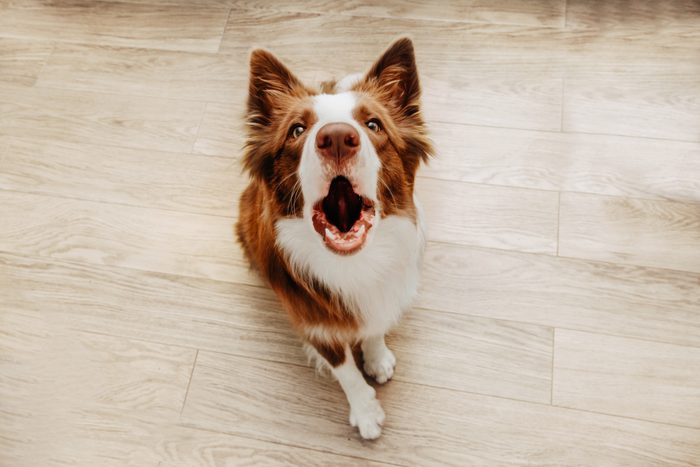
Your dog protects you from danger
When it comes to the signs your dog loves you, this one could literally be a lifesaver. Grottini experienced this firsthand when walking with her dog Chance, a Newfoundland, through town one day. “Chance pulled me away from someone who was riding a bike toward us,” she explains. But Chance wasn’t merely pulling Grottini out of the way of an oncoming cyclist, because they’d just tucked into a storefront entryway so the cyclist could pass. Chance sensed something else: The cyclist abruptly stopped and started talking to Grottini. The man’s speech was slurred, and it seemed like he was intoxicated, making Grottini feel very uncomfortable. “It was then that my dog fully pulled me away,” she adds.
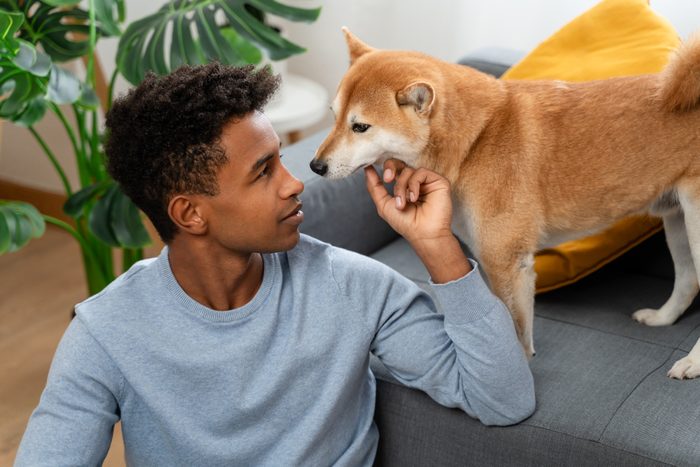
Your dog checks up on you
Thanks to a dog’s keen sense of smell (they have about 300 million scent receptors compared with our paltry 6 million), dogs can smell the pheromones we emit and decode the changes that occur. “A good example of a close relationship with your dog is if you fall and get hurt, they will come to you,” says Grottini. “They may sniff or try to lick you and stay with you until you get up. If you are ill, they may try to lay with you or will lay on the side of your bed until you get up.” While they keep watch over you, they will often look directly into your eye or show a half-moon eye, where the whites of their eye are prominent, conveying worry or stress.
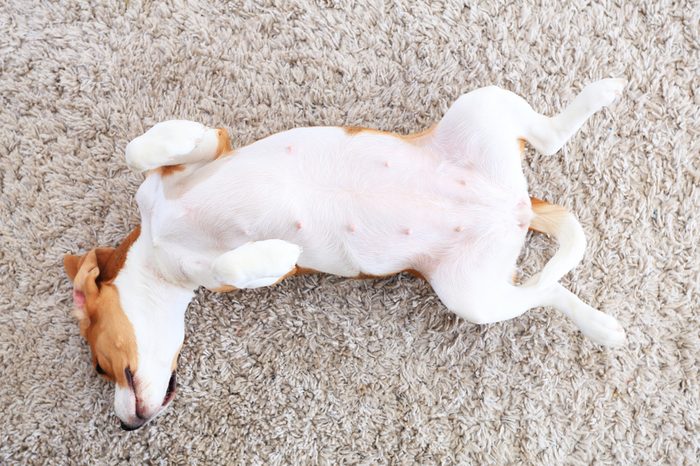
Your dog shows their belly
We’ve been programmed over the years to think that when our dogs show us their belly, they want a belly rub, thank you very much! But that’s not necessarily the case. Still, when they put themselves in a vulnerable position such as this, it is often a sign they love and trust you, says Grottini.
That said, an exposed belly isn’t always a green light for a tummy tickle. “When a dog rolls over and shows his belly, it can be a sign of trust, but it can also be a sign of discomfort,” says Nilson. “I’ve seen it in dogs that are scared or feel threatened in some way.” To know if it’s belly-rub time or back-off time, look at a dog’s overall body language. Dogs open to belly rubs will have loose and wiggly bodies and soft eyes.
Additional reporting by Charlotte Hilton Andersen.
About the experts
- Whitney Miller, DVM, MBA, DACVPM, is the chief veterinarian at Petco. Dr. Miller leads the Petco medical team, which supports more than 200 full-service hospitals and mobile vaccination clinics in Petco Pet Care Centers nationwide. In addition, Dr. Miller is a member of the Petco Pet Wellness Council (PPWC), an independent coalition of leading experts in veterinary science and animal care that serve as an external source of unbiased advice and counsel to Petco on a range of topics across the pet-care industry. Her furry family members include two dogs, Shelby and Jethro, a cat named Raya, and two guinea pegs, Cinnamon and Sugar.
- Susan Nilson, CAPBT (COAPE Association of Pet Behaviorists and Trainers) and PPAB (Pet Professional Accreditation Board), is the cat and dog training and behavior specialist at The Cat and Dog House. Susan also co-authored the book Pet Training and Behavior Consulting: A Model for Raising the Bar to Protect Professionals, Pets and Their People. She enjoys volunteering at dog shelters and hanging out with her menagerie of furry friends rescued from all over the globe. They include four rescue dogs (Roman, Florence, Lennox and Esme) and six rescue cats (Jethro, Spencer, Rainbow, Oakley, Jasmine and Kasper).
- Sally Grottini has been involved in professional dog training for 30 years and has been helping people with their dog-behavior questions on JustAnswer since 2007. She has been a Therapy Dog Evaluator for Therapy Dogs International for 13 years and a service dog trainer for Helping Paws for five years. Grottini has also worked with special-needs children at the Danville Child Development Center for 18 years, bringing her Newfoundland dogs—including her current dog, Phoenix—in for therapy visits.
Sources:
- Proceedings of the National Academy of Sciences: “Evolution of facial muscle anatomy in dogs”
- Nature: “Oxytocin increases trust in humans”
- Frontiers in Psychology: “Oxytocin and Cortisol Levels in Dog Owners and Their Dogs Are Associated with Behavioral Patterns: An Exploratory Study”
- PLoS One: “The Importance of the Secure Base Effect for Domestic Dogs – Evidence from a Manipulative Problem-Solving Task”
- Animals: “Dog–Owner Relationship, Owner Interpretations and Dog Personality Are Connected with the Emotional Reactivity of Dogs”
